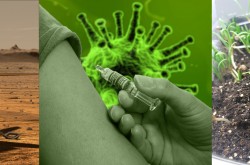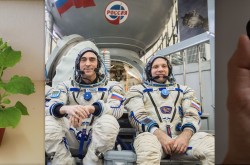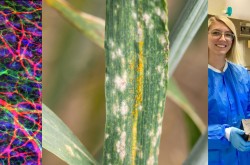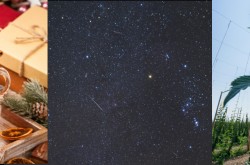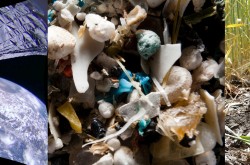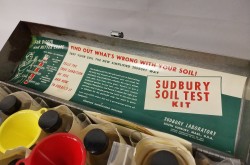3 things you should know about plastic-wrapped cucumbers, the James Webb telescope, and inflammation


Meet Renée-Claude Goulet and Michelle Campbell Mekarski.
They are Ingenium’s science advisors, providing expert scientific advice on key subjects relating to the Canada Agriculture and Food Museum and the Canada Science and Technology Museum. Jesse Rogerson, formerly the science advisor for the Canada Aviation and Space Museum, continues to lend his expert voice to the Channel.
In this colourful monthly blog series, Ingenium’s past and present science advisors offer up three quirky nuggets related to their areas of expertise. For the December edition, they tackled finding the perfect Christmas tree, what’s in a vaccine, and the twentieth anniversary of the International Space Station. For the July edition, they discuss how plastic wrap on cucumbers might soon be unnecessary, the first images from the James Webb Space Telescope, and how inflammation helps with healing.

Single-use plastic wrap on English cucumbers and many other types of produce may soon be a thing of the past, thanks to innovative food preservation technologies.
Why do cucumbers come wrapped in plastic, and what are we doing about it?
If you have ever wondered why English cucumbers come wrapped in plastic film, you are not alone! Knowing that single-use plastics are a bane of the environment, it can seem frivolous to wrap our food this way. But, there is in fact a good reason plastic wrap is used on certain produce: reducing food waste. If you need any convincing, the UN’s Food and Agriculture Organization estimates 40% of food produced globally goes wasted. That’s a big problem.
Naked cucumbers dehydrate quickly, becoming limp, and are vulnerable to damage during their journey from greenhouse to your fridge. By acting as a second skin, plastic film extends their shelf-life by almost a full week. The plastic protects from injuries that can let in agents of rot, such as bacteria, fungi and fruit flies, while also locking in moisture and blocking out oxygen, a main culprit in accelerating decay. Some types of cucumbers have thicker skin and naturally hold up better, and don’t benefit as much from a plastic coating.
On our transition to zero plastics, we find ourselves in a bit of a pickle when it comes to keeping food fresh. Truth is, in many cases, you can't get rid of packaging without affecting shelf-life, thus not helping the global food waste problem. Therefore, in the last decade or so, researchers and innovators have been exploring alternatives to this film, which would still allow to maintain optimal freshness, while eliminating the plastic waste.
Today, producers and distributors have begun implementing some of the more viable alternatives. Westmorland Topline Farms in Leamington, Ontario – a leading greenhouse grower – is completely nixing the plastic wrap and switching to a plant-based spray made by a Californian company called Apeel. The coating is made of lipids (fats, oils, waxes), and works with cucumbers’ natural protection against oxygen, evaporation, and invaders. The edible, colourless coating is as effective as plastic at providing a moisture and oxygen barrier. Another Leamington-based greenhouse grower, Nature Fresh, is instead opting for home-compostable bio-plastic film made from starch, which they developed in-house.
There are many other potential solutions in the works, and the innovations adopted for cucumbers will certainly pan out to other fruit and vegetables, further reducing our reliance on single use plastics, while avoiding food waste due to spoilage. We also have our role to play at home by learning the best storage conditions for different produce. To keep your cukes crisp and green - and keep plastic out of landfills, the environment and waterways - store them refrigerated, wrapped in beeswax wraps or in any airtight, reusable container or bag. Here’s to a waste-free future!
By Renée-Claude Goulet

The James Webb Space Telescope (JWST) is a partnership between the Canadian Space Agency, the European Space Agency, and NASA.
The first science images from the James Webb Space Telescope
The long-awaited James Webb Space Telescope (JWST) is the next great leap forward in space telescopes, building on knowledge gained from the Hubble Space Telescope. JWST was built with four science instruments, one of which was contributed by the Canadian Space Agency. That instrument is the Fine Guidance Sensor/Near InfraRed Imager and Slitless Spectrograph, or FGS/NIRISS.
JWST launched in December 2021, and after months of preparations is finally ready to start doing some hard science. To kick things off, the JWST team released the first full-colour science data, a series of five images highlighting a variety of targets and science. You can see all five here, but we’re going to focus on one image: the spectrum of WASP-96b’s atmosphere, which was collected by NIRISS.

This image shows the spectrum of the exoplanet WASP-96b’s atmosphere; data was collected by NIRISS, an instrument contributed by Canada to JWST.
This is a graph showing the composition of the atmosphere of WASP-96b, an exoplanet orbiting a star 1,150 light years away. WASP-96b is a gas giant planet (like Jupiter) and is orbiting its home star once every 3.4 days (compare that to Earth’s 365-day orbit around the Sun)! So how does this graph show the composition of the atmosphere?
From our point of view on Earth, each time this planet orbits, it passes in between us and its star, meaning, it blocks a little bit of the starlight for a brief moment every 3.4 days. But some of that starlight actually filters through the gas giant’s atmosphere and continues on to Earth. When the light goes through the exoplanet’s atmosphere, some of it is absorbed by the molecules there, leaving a signature, or a fingerprint, of the materials there.
In the data released on July 12th, the NIRISS instrument has found clear signs of water vapour in the exoplanet’s atmosphere. Now, don’t get too ahead of yourselves: yes, that’s water vapour, but it’s in the atmosphere of a Jupiter-like planet that is incredibly close to a star. There’s no life there. But what we’re really seeing here is a proof of concept: JWST, with the help of Canada’s NIRISS instrument, will be able to study the atmospheres of exoplanets! That means, we can search the atmospheres of exoplanets for signs of water, or methane, or even oxygen. All the hallmarks of life here on Earth may be found on some distant world, thanks to such an incredibly sophisticated telescope that we launched into space.
It’s exciting to see the most advanced space telescope ever built up and running, and ready to tackle the big questions, and even more exciting knowing that Canada is at the forefront of this research. These data released are just the tip of the iceberg; there are decades of astronomical discovery ahead of us.
By Jesse Rogerson

Even though we might associate pain, redness, swelling, and heat with injury, they’re actually signs that that your body is healing.
Hot, red, swollen, and painful? You’ve got inflammation
Imagine: you’re walking through your bedroom and BAM! You stub your toe. After yelling and hopping around for a minute, you look closer at your toe and notice it is red, swollen, hot to the touch, and painful. In fact, any time you injure yourself – a cut, a scrape, a bruise, a dislocation, or even a fracture – you’ll notice your body responds initially in pretty much the same way. This combination of four symptoms (heat, swelling, redness, and pain) is called inflammation – and it is one of your body’s first lines of defense against injury, toxins, and disease.
Any time you’re injured, your body has a few priorities: it wants to contain the spread of any nasty pathogens including viruses and bacteria, clean up the mess caused by the injury, and start the healing process. It accomplishes all this with inflammation.
When you’re injured (if you cut yourself or smash your toe against a bed frame) special cells called mast cells will start shooting out histamine molecules, which activate inflammation.
As histamine interacts with your blood vessels, it causes them to stretch out (dilate). Wider vessels transport extra blood to the injury site, making it red and hot. This might seem alarming, but it’s actually a good thing, since extra blood carries extra white blood cells and proteins that will be needed to fight infection and repair damage. The increased temperature also makes cells in the area more active, so that they can heal themselves faster.
Histamine doesn’t just stretch out your blood vessels, it also make the blood vessels around the injury site more permeable. In other words, they start to leak, allowing white blood cells and proteins to leave your bloodstream and travel directly to the site of injury. This is what causes the swelling. Swelling might be painful, but it’s a sign that your body is killing pathogens, forming clots and scabs, and repairing cells.
Finally, histamine acts like an alarm system. Histamine attracts extra white blood cells to the area, summoning them from other regions of your body. These reinforcements easily escape through the leaky blood vessels and jump into the fight, cleaning up pathogens and dead cells. In the case of a particularly nasty infection, they can also tell your body to mobilize more specialized attack cells.
Inflammation is just one of many strategies that your immune system uses to keep you healthy. Thanks to inflammation, your toe is able to heal so that you can continue stubbing it for the rest of your life.
Go further:
- If you’ve ever had seasonal allergies, you have probably taken antihistamines. As the name suggests, they work by blocking the effects of the histamine that’s released whenever your body interacts with an allergen. Blocking histamine helps prevent inflammation in the area of your body that the allergen affects, such as your skin if you pet a cat that you’re allergic to, or your eyes and nose if you’re outside in spring and allergic to pollen.
- Inflammation is a powerful – and critical – protection system. However, when inflammation runs uncontrolled in the body, it can lead to diseases and chronic conditions such as arthritis, inflammatory bowel disease, asthma, and transplant rejection.
By Michelle Campbell Mekarski
Enjoying the Ingenium Channel? Help us improve your experience with a short survey!






